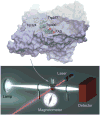Reaction kinetics and mechanism of magnetic field effects in cryptochrome
- PMID: 22171949
- PMCID: PMC3266978
- DOI: 10.1021/jp209508y
Reaction kinetics and mechanism of magnetic field effects in cryptochrome
Abstract
Creatures as varied as mammals, fish, insects, reptiles, and birds have an intriguing sixth sense that allows them to orient themselves in the Earth's magnetic field. Despite decades of study, the physical basis of this magnetic sense remains elusive. A likely mechanism is furnished by magnetically sensitive radical pair reactions occurring in the retina, the light-sensitive part of animal eyes. A photoreceptor, cryptochrome, has been suggested to endow birds with magnetoreceptive abilities as the protein has been shown to exhibit the biophysical properties required for an animal magnetoreceptor to operate properly. Here, we propose a theoretical analysis method for identifying cryptochrome's signaling reactions involving comparison of measured and calculated reaction kinetics in cryptochrome. Application of the method yields an exemplary light-driven reaction cycle, supported through transient absorption and electron-spin-resonance observations together with known facts on avian magnetoreception. The reaction cycle permits one to predict magnetic field effects on cryptochrome activation and deactivation. The suggested analysis method gives insight into structural and dynamic design features required for optimal detection of the geomagnetic field by cryptochrome and suggests further experimental and theoretical studies.
Figures






Similar articles
-
Orientation of birds in radiofrequency fields in the absence of the Earth's magnetic field: a possible test for the radical pair mechanism of magnetoreception.J R Soc Interface. 2024 Aug;21(217):20240133. doi: 10.1098/rsif.2024.0133. Epub 2024 Aug 7. J R Soc Interface. 2024. PMID: 39110232 Free PMC article.
-
Acuity of a cryptochrome and vision-based magnetoreception system in birds.Biophys J. 2010 Jul 7;99(1):40-9. doi: 10.1016/j.bpj.2010.03.053. Biophys J. 2010. PMID: 20655831 Free PMC article.
-
Chemical compass model of avian magnetoreception.Nature. 2008 May 15;453(7193):387-90. doi: 10.1038/nature06834. Epub 2008 Apr 30. Nature. 2008. PMID: 18449197
-
The Radical-Pair Mechanism of Magnetoreception.Annu Rev Biophys. 2016 Jul 5;45:299-344. doi: 10.1146/annurev-biophys-032116-094545. Epub 2016 May 16. Annu Rev Biophys. 2016. PMID: 27216936 Review.
-
Magnetoreception in birds.J R Soc Interface. 2019 Sep 27;16(158):20190295. doi: 10.1098/rsif.2019.0295. Epub 2019 Sep 4. J R Soc Interface. 2019. PMID: 31480921 Free PMC article. Review.
Cited by
-
The Static Magnetic Field Regulates the Structure, Biochemical Activity, and Gene Expression of Plants.Molecules. 2022 Sep 8;27(18):5823. doi: 10.3390/molecules27185823. Molecules. 2022. PMID: 36144557 Free PMC article. Review.
-
Weak Broadband Electromagnetic Fields are More Disruptive to Magnetic Compass Orientation in a Night-Migratory Songbird (Erithacus rubecula) than Strong Narrow-Band Fields.Front Behav Neurosci. 2016 Mar 22;10:55. doi: 10.3389/fnbeh.2016.00055. eCollection 2016. Front Behav Neurosci. 2016. PMID: 27047356 Free PMC article.
-
Atomistic Insights into Cryptochrome Interprotein Interactions.Biophys J. 2018 Aug 21;115(4):616-628. doi: 10.1016/j.bpj.2018.06.029. Epub 2018 Jul 30. Biophys J. 2018. PMID: 30078611 Free PMC article.
-
Cryptochrome and quantum biology: unraveling the mysteries of plant magnetoreception.Front Plant Sci. 2023 Oct 4;14:1266357. doi: 10.3389/fpls.2023.1266357. eCollection 2023. Front Plant Sci. 2023. PMID: 37860259 Free PMC article. Review.
-
Quantifying electron transfer reactions in biological systems: what interactions play the major role?Sci Rep. 2015 Dec 22;5:18446. doi: 10.1038/srep18446. Sci Rep. 2015. PMID: 26689792 Free PMC article.
References
Publication types
MeSH terms
Substances
Grants and funding
LinkOut - more resources
Full Text Sources

